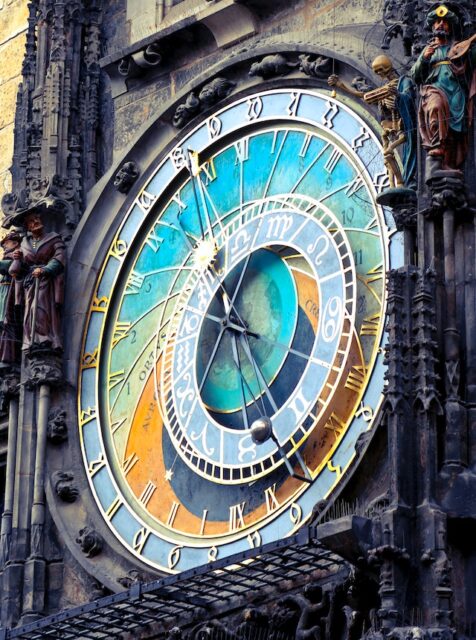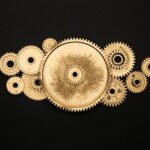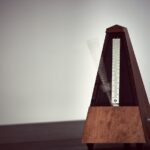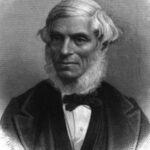Today, timekeeping is an integral part of our daily lives. The devices we use are very accurate and present everywhere. This was not the case for a very long time. Also in music, up till the invention of the metronome, timekeeping and tempo was rather based on individual feeling than science.
Time to organize society
Small tribes, later larger societies, but even a personal life could not be organized without instruments of timekeeping. The oldest societies known to have calendars and simple time measurement were the Babylonians and Egyptians, from at least 5 000 years ago. They introduced calendars to organize and coordinate communal activities. The Egyptian calendar was so advanced and accurate that later Julius Caesar made it official in Rome.
The earliest known timekeeping device – that is not calendar – was our old friend: the stick. Push a stick into the ground and watch the shadow move around, showing the passing of time. The concept of using the Sun and shadow is the same, but a big step forward was the sundial. This device broke the day into hours and the shadow moving around signaled more or less precisely the actual time.
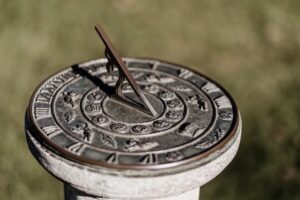
Measuring time by continuous processes was the next important step in timekeeping. The flow of liquid in water clocks, mechanical clocks, and eventually repetitive, oscillatory processes such as the swing of pendulums. Humans broke time into ever smaller parts, first to quarters, then minutes and seconds. In the 13th century artisans invented the mechanical clock, using gears and weights. These devices were good for simple everyday activities, but not yet for scientific measurements. This came only later. In the 17th century Dutch scientist Christiaan Huygens invented the pendulum clock, which provided great accuracy and precision in timekeeping.
With the miniaturization of clock mechanisms, pocket watches became popular in the 16th century. They allowed individuals to carry timekeeping devices with them and the expectation to be on time became the standard.
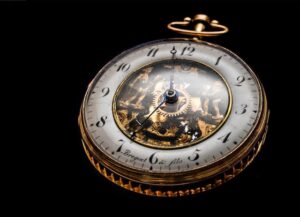
Another area where being on time is essential was rail transportation. To ensure train schedules were coordinated effectively in the 19th century time zones were introduced.
Soon, the human race entered the age of digital and atomic time keeping. In the 20th century quartz clocks became accessible that measure the time with the piezoelectric properties of quartz crystals. Atomic clocks, by measuring the vibrations of atoms, have the accuracy that is way beyond the need of everyday use, but essential in scientific activities.
Timekeeping in music
For a very long time, keeping precise timing in music was not important, at all. In ancient times music was almost always associated with text and this way the rhythm was dictated by the poetic meter, the natural flow of the text. The Medieval and Renaissance times gave us the first musical notations (neumatic notations), indicating the relative duration of notes.

As musical instruments were developing, more complex music followed. Precisely expressing the feeling or mood of a certain work required the composers to introduce a system of complex musical concepts, including ones defining the time.
Tempo refers to the speed of the music, sets the overall time and mood. Initially was described with Italian words like andante (moderate) or allegro (fast). More on tempo markings in our article, here!
Beat refers to the underlying pulse or rhythm of the music, these are regular intervals like quarter or eight notes.
Meter is the organization of beats into groupings called measures or bars. Common meters are 2/4, 3/4, and 4/4. Top number of the meter signifies the number of beats per measure, while the bottom number indicates the type of note that receives one beat (e.g., quarter note, eighth note).
As composers produced music ever more complex, orchestras grew in kind and number of instruments, a new role in music emerged to organize and keep proper timing: the conductor. Conductors began to emerge in the 17-18th centuries, taking the responsibility of leading the ensemble and maintaining a unified sense of time.
Until the invention of the metronome by Johann Nepomuk Maelzel in 1816, interpretation of the musical instructions made by the composers – within certain limits – were subject to individual readings, depending on the momentary mood or temperament of the composer. In a way, the metronome markings killed this personalization and made the musical timing a science, instead of art. In return, composers could express their timing wishes precisely.
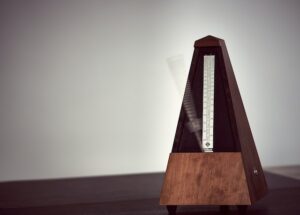
Throughout history, timekeeping in music has evolved parallel to the demands of musical compositions, their performances, and technological advancements. The development of notation systems, the invention of mechanical clocks, the emergence of conducting, and the invention of the metronome have all contributed to the refinement, allowing musicians to create and perform music with greater precision and rhythmic complexity.
If not in the invention itself, but in bringing the device to attention, Beethoven had an important role to play in the history of the metronome. Once his friend (and later his foe) Maelzel finished and introduced his invention, Beethoven made and published the metronome timings of his most recent compositions. Unfortunately, by the time his deafness was already in advanced stage and his inner sense of tempo versus the physically audible music differed greatly. This way we have no exact indication of time for any of his compositions.
